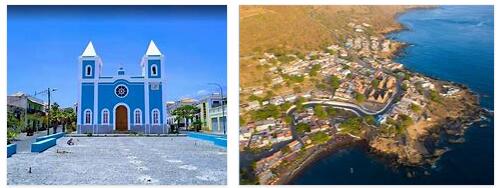Cities in Cape Verde
Sao Vicente (Cape Verde)
São Vicente [SA vi senti], one of Cape Verde ( Cape Verde ) to 730 m above the sea level, in the northwest of the archipelago; 227 km 2, (2017) 82 700 residents, very densely populated.
The main town is Mindelo with the port of Porto Grande; Airport.
Sao Tiago
São Tiago [SA t agu], Santiago, the largest of the Cape Verde ( Cape Verde ), up to 1 393 m above sea level, 1004 km 2, (2017) 301,900 residents; The main town and capital of the country is Praia (with port and international airport) on the south-east coast of the island.
Cultivation of corn, beans, bananas, sugar cane and citrus fruits, extensive reforestation programs, fishing and processing.
Cidade Velha, now a fishing village and the administrative seat of the Ribeira Grande district on São Tiago, became the Cape Verde Islands’ first UNESCO World Heritage Site in 2009. Founded by the Portuguese in the late 15th century under the name Ribeira Grande, it was the first permanent settlement of Europeans in the tropics and a center of the transatlantic slave trade.
Sao Nicolau
São Nicolau [SA Niku la ], one of Cape Verde ( Cape Verde ) to 1 304 m above sea level, 345 km 2, (2017) 12,300 residents.
The main town is Ribeira Brava (7,000 residents); Coffee growing, fishing; Airport.
Santo Antão
Santo Antao [ santu to tã ], the northwestern of Cape Verde ( Cape Verde ) to 1979 m above sea level; with 785 km 2 the second largest island in the archipelago, (2017) 39 300 residents.
The main town is Ribeira Grande (5 500 residents), the largest port of Porto Novo on the southeast coast. The island is of volcanic origin and is very mountainous; Growing sugar cane, bananas, vegetables, fruits and coffee.
Sal
Sal, northeasternmost of Cape Verde. Islands ( Cape Verde ), 220 km 2, (2017) 36 800 residents; The main town is Santa Maria (17,000 residents).
Salt extraction, rapidly expanding water sports tourism; international airport in Espargos.
Maio
Maio [Portuguese ma u], one of the southern Cape Verde Islands ( Cape Verde ), 274 km 2, (2017) 7100 residents; The main town is Vila do Maio (3,000 residents) with the port of Porto Inglẽs and the airport.
Fogo
Fogo [ fo ɣ u], one of the southwestern Cape Verde ( Cape Verde ), 471 km 2, (2017) 35 400 residents; The main town is São Filipe (8,100 residents).
In Pico de Fogo 2,829 m above sea level (active volcano, last eruption November 2014 to February 2015); Fishing and canning of fish, wine, coffee and vegetable growing in the north.
Airports in Mosteiros and São Filipe.
Brava
Brava, the most south-westerly of the Cape Verde Islands ( Cape Verde ), up to 976 m above sea level, 63 km 2, (2017) 5,600 residents; The main town is Vila Nova Sintra (1,100 residents).
The economy is based on the remittances of emigrated islanders, supplemented by some irrigation agriculture and a still underdeveloped tourism.
Boa Vista (Cape Verde)
Boa Vista, the most easterly of the Cape Verde Islands ( Cape Verde ), 631 km 2, (2017) 16 600 residents; The main town is Sal Rei (5,400 residents).
Numerous beaches and reefs, expanding tourism; Airport.
Boa Vista was discovered in 1456 and was the seat of the Portuguese-British Commission for the Abolition of Slavery in 1843.
Cities in Burkina Faso
Burkina Faso, officially French République de Bourkina Faso [repy Republic də bur-], German Republic Burkina Faso, a landlocked country in West Africa with (2019) 20.3 million residents; The capital is Ouagadougou.
Koudougou
Koudougou [kudu gu], Kudugu, city in Burkina Faso, west of Ouagadougou rail to Abidjan, (2018) 120 100 residents.
Catholic bishopric, university (founded in 2005; trade center; soap production, textile factory.
Bobo Dioulasso
Bobo-Dioulasso [-diu-], Bobo-Diulasso, second largest city in Burkina Faso, West Africa, in a mountainous savannah landscape, 450 m above sea level, (2018) around 1 million residents.
Provincial capital; catholic archbishop’s seat; Cotton Research Institute; important trading center and industrial location (cotton, tobacco and other agricultural products, livestock). Road junction on the Abidjan – Ouagadougou railway line; international Airport.
Mosques in Sudanese earth building style.
Ouagadougou
Ouagadougou [Waga Dugu], capital of Burkina Faso, with (2018) 2.5 million residents.
Ouagadougou is a culturally (university, national museum) and economically important center of the country.
